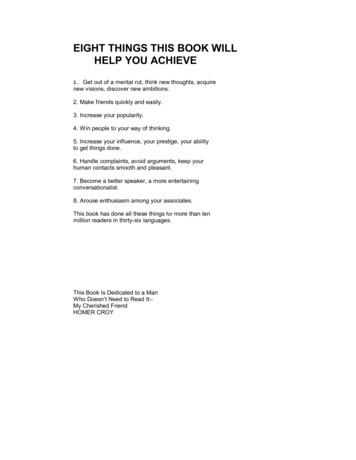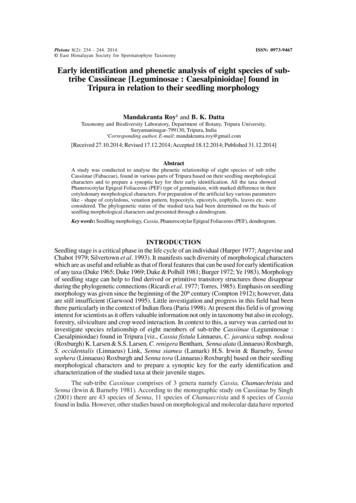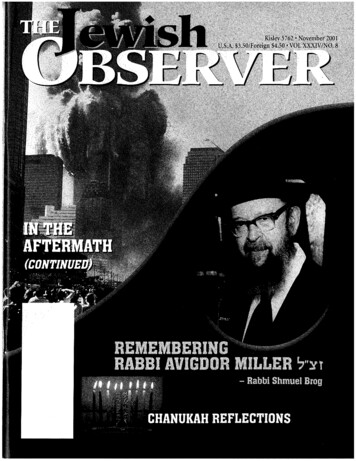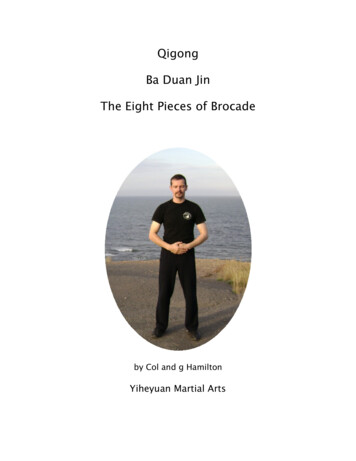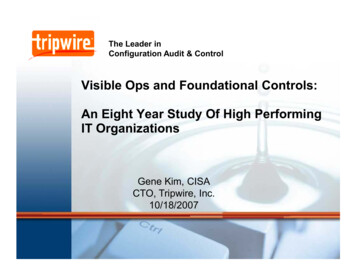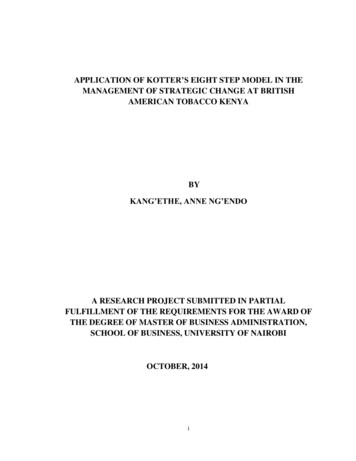
Transcription
APPLICATION OF KOTTER’S EIGHT STEP MODEL IN THEMANAGEMENT OF STRATEGIC CHANGE AT BRITISHAMERICAN TOBACCO KENYABYKANG’ETHE, ANNE NG’ENDOA RESEARCH PROJECT SUBMITTED IN PARTIALFULFILLMENT OF THE REQUIREMENTS FOR THE AWARD OFTHE DEGREE OF MASTER OF BUSINESS ADMINISTRATION,SCHOOL OF BUSINESS, UNIVERSITY OF NAIROBIOCTOBER, 2014i
DECLARATIONThis research project is my original work that has not been submitted for examination toany other University.Signed: . Date: .ANNE NG‟ENDO KANG‟ETHED61/60420/2013This research project has been submitted for examination with my approval as theuniversity supervisor.Signed: . Date: .Prof. MARTIN OGUTU (PhD)DEPARTMENT OF BUSINESS ADMINISTRATIONSCHOOL OF BUSINESSUNIVERSITY OF NAIROBIii
ACKNOWLEDGEMENTSI thank the Almighty God for giving me the opportunity to undertake this project. Hisgrace has been sufficient for me throughout this project. All glory goes back to Him.I wish to thank my supervisor Prof. Martin Ogutu for agreeing to supervise this researchproject.I am also grateful to BAT Kenya for allowing me to collect data for the research.iii
DEDICATIONTo my dear mother, Esther N. Kang‟ethe, who has supported me from the first day,praying for me and cheering me on. To my dad in absentia (RIP), this is for you, I knowyou are proud of me. To my siblings Njambi and Schuiy, thank you so much for theunderstanding and support.To Steve, thank you so much for the invaluable support.Thank you all and may God bless you abundantly!iv
ABSTRACTThe business environment is very dynamic with various forces bombarding theorganizations. It is hence imperative for the organizations to put in place strategies foradapting and adopting new practices that will enable the organizations successfullysurvive the tides. In doing this the organizations need not rely on experience and oldways of doing things. It is imperative for organizations to adopt tried processes that willenable them achieve their change objectives within the limited time and using the limitedresources. Many models have been suggested to guide the change process. These modelscan be adopted by organizations in order to manage the change process successfully andin an efficient manner. This study mainly focused on Kotter‟s eight step model. The studyaimed at determining the change management process adopted by BAT Kenya. It alsotried to determine to what extent does the change management process compare andrelate to Kotter‟s eight step model. The study also aimed at establishing the challengesencountered by BAT Kenya in the process of managing change. This research adopted acase study research design with focus on BAT Kenya. Data collection was done by use ofinterview guides. The interviewees were five key managers at BAT. Content analysis wasthen carried out on the collected data and generalizations drawn to achieve the objectivesof study. The research study has shown that BAT is responsive to changes in theenvironment and has put functions in its structure to handle change as and when needed.Research study has also shown that BAT adopts Kotter‟s eight step model in themanagement of change of the bigger projects in that it has followed the eight steps andhas only skipped a few steps when it was handling smaller projects. The researcherrecommends the firm focuses and invests more on human capital which is inimitable inorder to remain competitive in the industry.v
TABLE OF CONTENTSDeclaration .iiAcknowledgements . . .iiiDedication . ivAbstract . . . .vCHAPTER ONE: INTRODUCTION1.1 Background of the Study . .11.1.1Management of Strategic Change. .21.1.2Kotter‟s Eight Step Model . .31.1.3Tobacco Industry in Kenya . .51.1.4British American Tobacco (Kenya) Limited . .61.2 Research Problem .71.3 Research Objectives .91.4 Value of the Study .9CHAPTER TWO: LITERATURE REVIEW2.1 Introduction . . . .112.2 Theoretical foundation. . .112.3 Kotter‟s Eight Step Model and management of change .142.4 Change Management Challenges . .21vi
CHAPTER THREE: RESEARCH METHODOLOGY3.1 Introduction . .253.2 Research Design .253.3 Data Collection .263.4 Data Analysis .26CHAPTER FOUR: FINDINGS AND DISCUSSIONS4.1 Introduction 284.2 Information on Interviewees . 284.3 Change Management Process at BAT K . . 294.4 Change Management Challenges at BAT K . 334.5 Discussions .36CHAPTER FIVE: SUMMARY, CONCLUSION AND RECOMMENDATIONS5.1 Introduction 385.2 Summary . . 385.3 Conclusion . .405.4 Recommendations . .415.5 Limitations of the Study . . 425.6 Suggestions for Further Research . . .42vii
REFERENCES 44APPENDICES . . .49APPENDIX 1: Interview Guide . . . . .49APPENDIX 2: Letter to Respondents . 51viii
CHAPTER ONEINTRODUCTION1.1 Background of the StudyThe business world is a dynamic sphere, with different forces bombarding theorganizations and causing them to either adjust to the changes or be kicked out ofbusiness. Ability of the organizations to remain fluid in their systems and structure is keyin ensuring they will adapt to new changes and easily adopt new best practices thatenable them remain suave in the turbulent environment. Change is not easy to initiate andmanage in an organization because majority of the people would rather maintain thestatus quo for fear of the unknown. There are various models that can be used to managechange in an organization. One such model that this study will focus on is the Kotter‟seight step model, Kotter (1995), which is an eight step process in the management ofchange in an organization.This study was anchored on two theories; the resource base view theory and the dynamiccapabilities theory. The resource based view theory as explained by Barney (1991)explains that an organization‟s basis of competitive advantage lies in the application ofresources at its disposal. For this resources to hold water in this theory they must bevaluable, rare, inimitable and non substitutable. The dynamic capabilities theory, Teece(1997) was illustrated as the firm‟s ability to integrate build and reconfigure internal andexternal competences to address rapidly changing environments. These two theories arelinked in the sense that they both address the resources and the competences anorganization needs in order to remain relevant in the ever changing business environment1
and have an upper hand against rivals. These theories will help in the understanding ofthe management of strategic change at BAT Kenya and the application of the Kotter‟seight step model.The study focused on BAT Kenya‟s change management system to check on theapplication of the Kotter‟s eight step model in the management of change brought aboutby the enactment of the Tobacco Control Act, 2007. BAT Kenya is a good case study forthis research because it has faced many threats and challenges that have forced theorganization to rethink its strategy, structure and systems in the management of thischange. As explained by Mbuthia (2012), BAT Kenya has set aside resources andempowered its management in handling the threat to ensure it is business as usual amidthe tight regulations. It is imperative for organizations to have clear cut process of dealingwith the change and use models that have been tried and tested by other successfulorganizations. There are various models used in the curbing of the changes that occur inthe business environment. This study focused on the adoption of the Kotter‟s eight stepmodel as coiffed by (Kotter, 1995). Kotter‟s model is the most comprehensive of thechange models and the most common.1.1.1 Management of Strategic ChangeCompanies with rigid structures, cultures and systems, risk being kicked out of businessbecause only the organizations with dynamic systems get sifted through. Davis andHolland (2002) explained that change management is the use of systematic methods toensure that an organizational change can be guided in the planned direction, conducted in2
a cost effective manner and completed within the targeted time frame and with thedesired results.Recent research has shown that developing change management as a discipline willremove the past notion that change can be handled in an ad hoc basis, occasionally aidedby experience. Change management tends to be problem or need based in that it seeks toget a solution to a mind boggling problem.Change in the organization can be caused by forces internally or externally. The forces asobserved by Kotter (1999) can be driven by political, economic, social or technologicalfactors. These changes are normally beyond the control of the management and for thisreason organizations need to face the looming threats and opportunities head on withstrategies on how to reduce its effect on the organization or work around the eventualityfor their own good. The reaction to these changes can either be reactive, where anorganization aligns and realigns its systems and structures to accommodate a threat as isthe case of a regulation in BAT Kenya or proactive where an organization placescontinuous measures to ensure their systems and structures are positioned in a fluidmanner to adjust to any changes in the environment (Nutt, 2001).1.1.2 Kotter’s Eight Step ModelThere are different change management models that are used in the management ofchange in the organizations. This study focused on the Kotter‟s eight step model. This isan eight step process that defines the manner of handling change in an organization3
(Kotter, 1995). It offers a holistic approach to implement far-reaching organizationalchange.The first step is establishing a sense of urgency. It is imperative for the management toconvince the employees and staff of the urgency of taking new direction in theorganization. Kotter advised that the management should help others feel a gut-leveldetermination to move and win now (Kotter, 2011). The second step is the creation of aguiding coalition. A coalition of people to lead the change effort should be formed. Theteam should have enough power, credibility, expertise, excellent leadership skills and ashared objective to foresee the success of the change (Kotter, 2011).Third step is the development of a change vision. Kotter (1995) observed that developinga vision for the future is crucial at this point because it serves as a basis for decisionmaking, motivates people to take action in the right direction and help coordinate actionsof different people in a fast and efficient way. The forth step is the communication of thevision for buy-in. To get a buy in with the employees on the vision it needs to becommunicated throughout the organization. Kotter advised that under-communicationand inconsistence is extremely common. Successful leaders, he says, use everycommunication channel possible to broadcast the vision daily. The fifth step is aboutempowering broad based action among the employees. Kotter (1995), once theemployees accept the new vision, they need to be empowered to act upon it. The guidingcoalition has the responsibility of removing any barriers and make sure people have theresources, tools and systems to bring about the change.4
The sixth step is the generation of short-term wins. Research shows that organizationstend to lose the change momentum very quickly. To keep the sense of urgency and fireblazing, short term wins are essential. Kotter (2011) explained that companies thatexperience significant short-term wins are much more likely to complete a transformationprocess. The seventh step is consolidation of gains to produce more change. Kotterwarned that organizations should not declare victory before the changes and businessimprovements have sunk deeply into a company‟s culture as this may kill ongoingmomentum allowing resistors to take over.The final step is the incorporation of changes into the culture. This step is aboutincorporating and anchoring the new practices and approaches into the corporate culturein order to make it stick and not get lost as soon as the pressure of change subsides,(Kotter, 2011).1.1.3 Tobacco Industry in KenyaThe tobacco industry was introduced in Kenya by the British traders in the early 20thcentury. British American Tobacco was the first tobacco manufacturer in Kenya andenjoyed monopoly advantages until 1990s when competition entered the market withcompanies like Mastermind Tobacco Kenya, Cut Tobacco, RJR Reynolds and IslandTobacco debuting their products and plants.BAT faced a lot of competition and needed to place new strategies in its marketing,human resources, brands, and supply chain departments in order to remain the leadingtobacco company and maintain its market share. Entry of new players also saw a5
scramble for the tobacco farmers. This increased the bargaining power of these suppliers(Mbuthia, 2012).The industry has experienced a lot of challenges over the years especially with theenactment of the Tobacco Control Act 2007 that banned smoking in public places,advertising and promotions and packaging and labeling. Other challenges faced by theindustry include high taxe
All glory goes back to Him. I wish to thank my supervisor Prof. Martin Ogutu for agreeing to supervise this research project. I am also grateful to BAT Kenya for allowing me to collect data for the research. iv DEDICATION To my dear mother, Esther N. Kang‟ethe, who has supported me from the first day, praying for me and cheering me on. To my dad in absentia (RIP), this is for you, I know you .
